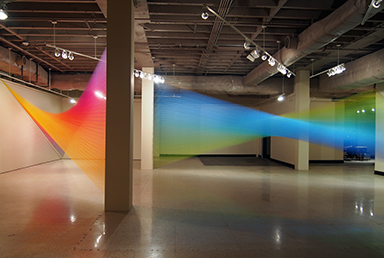Plexus No.26
Jun 5–Aug 3, 2014
Image Gallery

OLYMPUS DIGITAL CAMERA

OLYMPUS DIGITAL CAMERA
Plexus No.26
Jun 5–Aug 3, 2014
June 5 – August 3, 2014
Project Space
Featuring Gabriel Dawe
Contemporary at Blue Star Art Museum announces “Plexus no.26,” an exhibition by Dallas, TX based artist Gabriel Dawe, from June 5 through August 3, 2014. An Opening Reception will take place Thursday, June 5 from 6:00 to 9:00 pm, and is open and free to the public.
BIOGRAPHY:
Originally from Mexico City, Gabriel Dawe creates site-specific installations that explore the connection between fashion and architecture, and how they relate to the human need for shelter in all its shapes and forms. His work is centered in the exploration of textiles, aiming to examine the complicated construction of gender and identity in his native Mexico and attempting to subvert the notions of masculinity and machismo prevalent in the present day. His work has been exhibited in the US, Canada, and several European countries. After living in Montreal, Canada for 7 years, he moved to Dallas, Texas, where he obtained his MFA at the University of Texas at Dallas. For the final two years of his degree, he was an artist in residence at CentralTrak, the Artist in Residency program at UTD. His work has been featured in national and international publications, including Sculpture magazine, the cover of the 12th edition of Art Fundamentals published by McGraw-Hill, and in author Tristan Manco’s book Raw + Material = Art . He is represented by Conduit Gallery in Dallas, Zadok Gallery in Miami, and by Lot 10 Gallery in Brussels.
ARTIST STATEMENT:
The Plexus series is an ongoing series of installations that explore thread and fibers as loaded materials that implicate the complicated construction of gender and identity not only in the artist’s home country, Mexico, but throughout the western world. These installations relate to the human need for shelter and protection, and the way Fashion and Architecture are employed to address vulnerability, not only on a physical level, but also on a psychological and emotional one. In using sewing thread—the core component of clothing—to generate an architectural structure, scale and material are switched around to create a new construction that no longer shelters the material needs of the body, but instead creates something that becomes a symbol of the non-physical structures humanity needs to survive as a species. Such a delicate material gives these ethereal structures a luminous presence that despite its subtlety is paradoxically powerful. The succession of lines in a three-dimensional pattern is organized with precision, thus creating a visual effect that plays with the viewer’s perception. Such effect makes these installations a full sensorial experience.